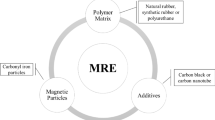Abstract
Magnetorheological elastomers (MRE) as intelligent materials are quite popularly used, both for indoor and outdoor applications that are often exposed to rain or sunlight depending on weather changes. In this case, the use of MRE material in outdoor use with exposure to freshwater and seawater needs further analysis. The analysis can then be used to evaluate the performance of the MRE. MRE specimens were molded in an isotropic state with vacuum treatment. Furthermore, the immersion treatment of the specimens was carried out for 6 weeks. In the 6-week immersion test, all specimens of material dissolution were dissolved, which was proven by a decrease in the percentage of absorption. The largest dissolution occurred in the 0%wt CIP heavy fraction specimen with seawater immersion treatment. In the hardness test of Durometer Shore A, both specimens of 0%wt CIP heavy fraction showed an increase in hardness, while in 70%wt CIP heavy fraction specimens, the opposite occurred. The greatest decrease occurred in specimens treated with freshwater immersion. The decrease in hardness can affect the stiffness of the material, resulting in a decrease in the dam** function. The FTIR test showed that there were new peaks found in seawater immersion specimens.
Access this chapter
Tax calculation will be finalised at checkout
Purchases are for personal use only
Similar content being viewed by others
References
Carlson, J.D., Jolly, M.R.: MR fluid, foam and elastomer devices. Mechatronics 10, 555–569 (2000)
Cantera, M.A., Behrooz, M., Gibson, R.F.: Modeling of magneto-mechanical response of magnetorheological elastomers (MRE) and MRE-based systems: a review. Smart Mater. Struct. 26, 023001 (2017)
**n, F., Bai, X., Qian, L.: Principle, modeling, and control of a magnetorheological elastomer dynamic vibration absorber for powertrain mount systems of automobiles. J. Intell. Mater. Syst. Struct. 28(16), 2239–2254 (2016)
Kavlicoglu, B., Wallis, B., Sahin, H., Liu, Y.: Magnetorheological elastomer mount for shock and vibration isolation, vol. 7977, no. 775, pp. 1–7 (2011)
Sun, S., Yang, J., Du, H., Zhang, S., Yan, T.: “Development of magnetorheological elastomers – based tuned mass damper for building protection from seismic events. J. Intel. Mater. Syst. Struct. 29(8), 1777–1789 (2018)
Zhao, L., Yu, M., Fu, J., Zhu, M., Li, B.: A miniature MRE isolator for lateral vibration suppression of bridge monitoring equipment: design and verification. Smart Mater. Struct. 26(4), 047001 (2017)
Lian, C., Lee, K.H., Lee, C.H.: Effect of temperature and relative humidity on friction and wear properties of silicone-based magnetorheological elastomer. Tribol. Trans. 61(2), 238–246 (2018)
Khanouki, M.A., Sedaghati, R., Hemmatian, M.: Characterization of Magneto-Mechanical Properties and Quasi-Static Physical Modelling of MR Elastomers, no. January, pp. 1–9 (2019)
Ubaidillah, Sutrisno, J., Purwanto, A., Mazlan, S.A.: Recent Progress on Magnetorheological Solids: Materials, Fabrication, Testing, and Applications, pp. 1–35 (2014)
Author information
Authors and Affiliations
Corresponding author
Editor information
Editors and Affiliations
Rights and permissions
Copyright information
© 2022 The Author(s), under exclusive license to Springer Nature Singapore Pte Ltd.
About this paper
Cite this paper
Wibowo, Krismawati, N., Lenggana, B.W., Ubaidillah, Ariawan, D., Imaduddin, F. (2022). Analysis of Magnetorheological Elastomers Under Liquid Immersion. In: Abdollah, M.F.B., Amiruddin, H., Phuman Singh, A.S., Abdul Munir, F., Ibrahim, A. (eds) Proceedings of the 7th International Conference and Exhibition on Sustainable Energy and Advanced Materials (ICE-SEAM 2021), Melaka, Malaysia. ICE-SEAM 2021. Lecture Notes in Mechanical Engineering. Springer, Singapore. https://doi.org/10.1007/978-981-19-3179-6_20
Download citation
DOI: https://doi.org/10.1007/978-981-19-3179-6_20
Published:
Publisher Name: Springer, Singapore
Print ISBN: 978-981-19-3178-9
Online ISBN: 978-981-19-3179-6
eBook Packages: EngineeringEngineering (R0)




